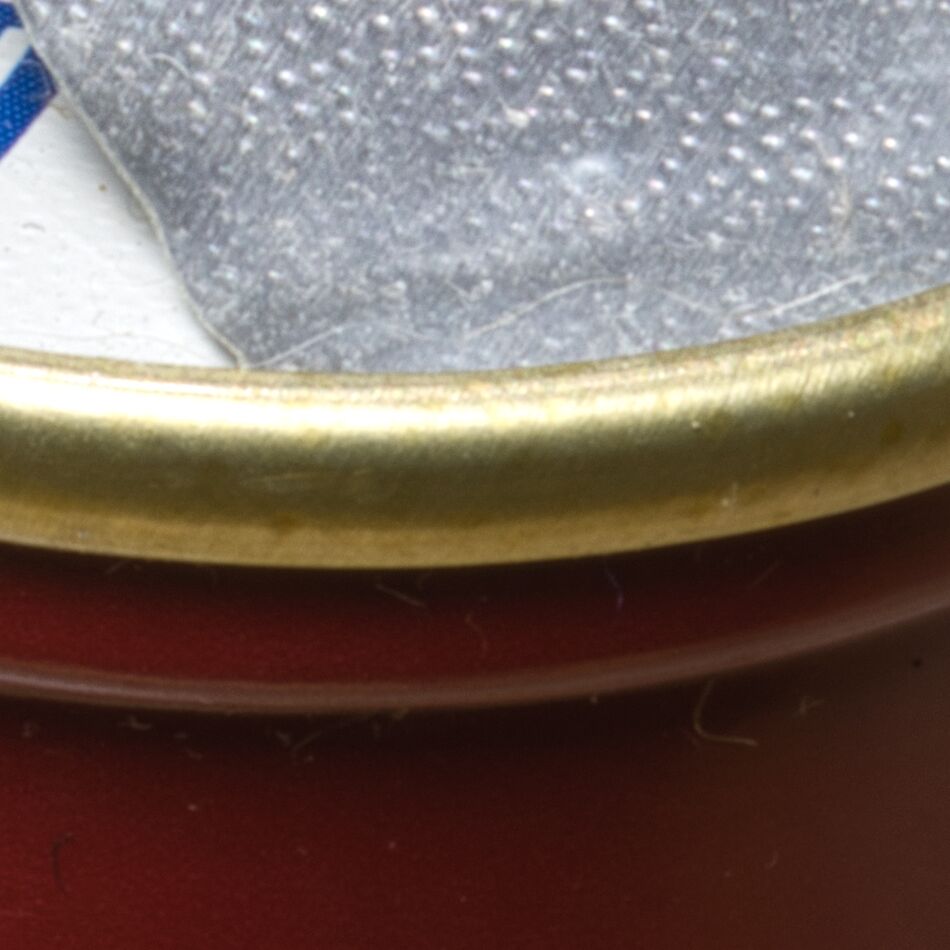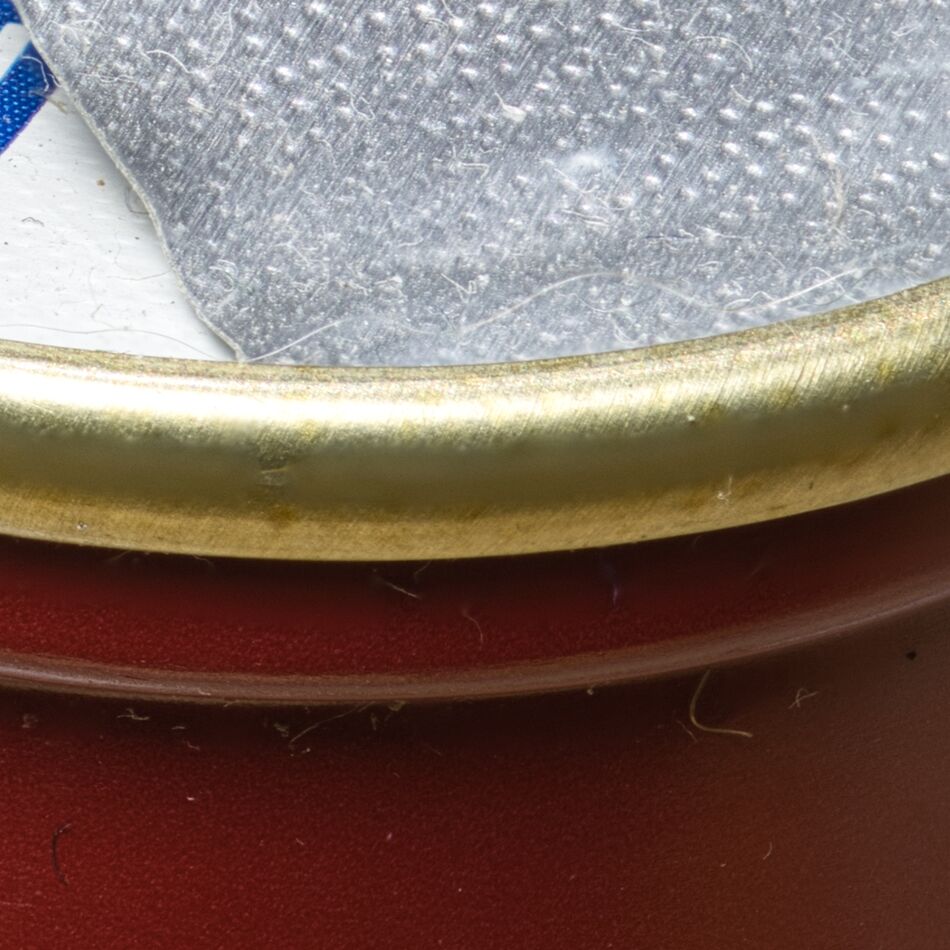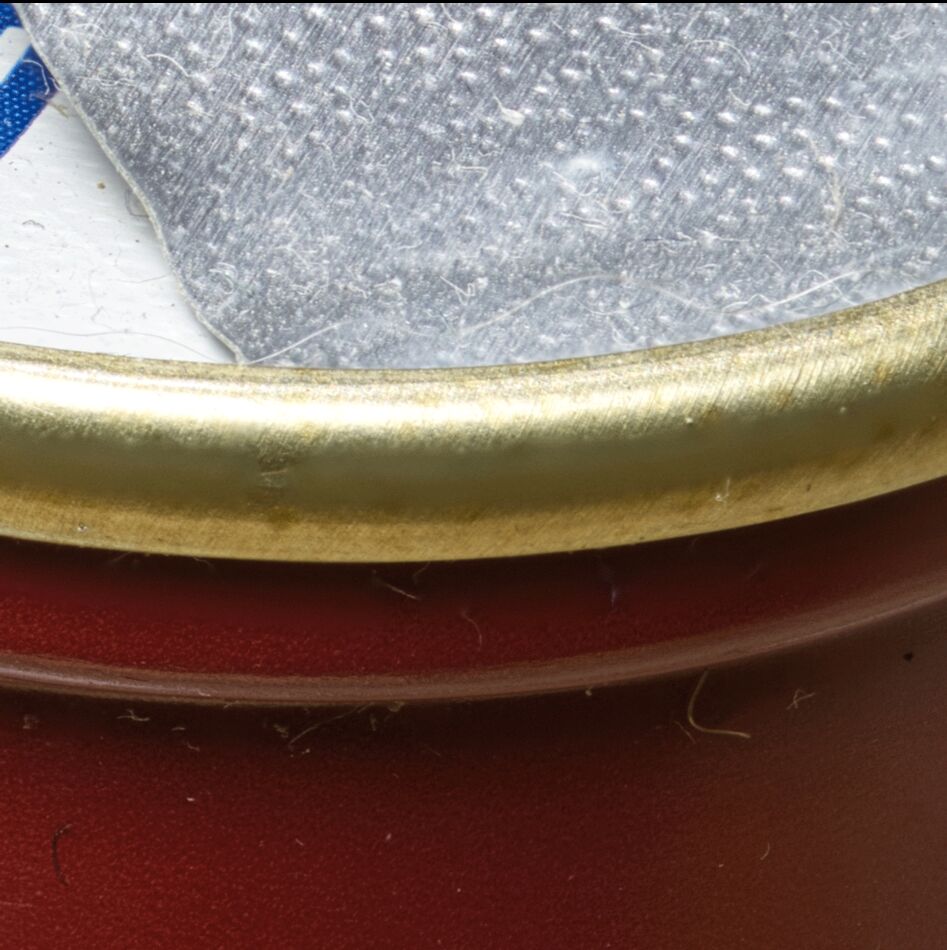Diffraction II
Dec 16, 2023 17:52:04 #
In this test I did focus bracketing at two different apertures - f/32 and f/8 - and then used Zerene for stacking. As in the previous test, I am working with the Canon 90D, 180mm Macro lens, at ISO 100, and King Oscar mackerel fillets in olive oil.
Here are the results, with the images resized for posting.
 mackstack1A on Flickr f/32
mackstack1A on Flickr f/32
 mackstack2A on Flickr f/8
mackstack2A on Flickr f/8
The previous thread about diffraction is here:
https://www.uglyhedgehog.com/t-794383-1.html
Here are the results, with the images resized for posting.
 mackstack1A on Flickr f/32
mackstack1A on Flickr f/32 mackstack2A on Flickr f/8
mackstack2A on Flickr f/8The previous thread about diffraction is here:
https://www.uglyhedgehog.com/t-794383-1.html
Dec 16, 2023 17:55:20 #
Now a closer look. The following are crops from each image when viewed at 100%.
Dec 16, 2023 18:13:42 #
According to some, the f/32 version should be heading straight for the bin, especially since it's a crop sensor camera. I recon that if the f/32 sharpening got an extra tweak it would put it on much the same level as the f/8 version (and that includes the 100% view).
Dec 16, 2023 18:33:49 #
R.G. wrote:
According to some, the f/32 version should be heading straight for the bin, especially since it's a crop sensor camera. I recon that if the f/32 sharpening got an extra tweak it would put it on much the same level as the f/8 version (and that includes the 100% view).
Maybe.
As before, I am not claiming that one is "better" than the other.
I am not sure what you mean when you say "especially since it's a crop sensor camera."
Dec 16, 2023 19:08:36 #
Blenheim Orange wrote:
.....I am not sure what you mean when you say "especially since it's a crop sensor camera."
With a crop sensor camera, everything gets proportionately smaller, including the aperture. That applies to APS-C, m4/3, 1" sensor cameras and so on. It's generally accepted that with full frame cameras the onset of diffraction becoming noticeable happens at around f/11. With APS-C sensor cameras it's f/8 and with m4/3 cameras it's f/5.6.
Dec 16, 2023 19:12:05 #
R.G. wrote:
With a crop sensor camera, everything gets proportionately smaller, including the aperture. That applies to APS-C, m4/3, 1" sensor cameras and so on. It's generally accepted that with full frame cameras the onset of diffraction becoming noticeable happens at around f/11. With APS-C sensor cameras it's f/8 and with m4/3 cameras it's f/5.6.
Got it. Thanks.
Dec 16, 2023 20:14:19 #
Blenheim Orange wrote:
Now a closer look. The following are crops from each image when viewed at 100%.
Blink test shows there is a difference. Not judging 'better'. The 1b image is shown for 2 seconds, the 2b image for 0.5 second so you can tell which is which.
Note: you have to download the image to get the animated gif to run.
Dec 16, 2023 20:19:41 #
DirtFarmer wrote:
Blink test shows there is a difference. Not judging 'better'. The 1b image is shown for 2 seconds, the 2b image for 0.5 second so you can tell which is which.
Very good!
There definitely is a difference. Whether or not that difference matters to the photographer or to the viewer is another thing.
Dec 17, 2023 06:31:49 #
R.G. wrote:
With a crop sensor camera, everything gets proportionately smaller, including the aperture. That applies to APS-C, m4/3, 1" sensor cameras and so on. It's generally accepted that with full frame cameras the onset of diffraction becoming noticeable happens at around f/11. With APS-C sensor cameras it's f/8 and with m4/3 cameras it's f/5.6.
The aperture does not get smaller based on the sensor size. The OP is using the same 180 mm macro. The approximate diameter of the aperture at f8 is 180/8 of 22.5 mm and at f/32 5.625 mm. The difference is that the diffraction is more noticeable on so called cropped sensors because the image is enlarged more to have the same size view or print.
Dec 17, 2023 07:41:55 #
bikerguy wrote:
......The difference is that the diffraction is more noticeable on so called cropped sensors because the image is enlarged more to have the same size view or print.
OK, I wasn't sure which way round it went. But the result is as I described in my last two sentences.
Just in the passing, what you described could have been said in terms of the circle of confusion and the pixel density, which is why the sensor resolution is also a factor. But for the sake of keeping things simple we only have to compare like with like, which is being achieved by using the same sensor (and therefore the same pixel density) for both images.
Dec 17, 2023 07:55:38 #
Blenheim Orange wrote:
......Whether or not that difference matters to the photographer or to the viewer is another thing.
The point of using a 100% view is that it's more revealing, which indicates that the amount of cropping is another factor. However, it takes quite a lot of cropping to get to the 100% view, and at that level the significance of the differences is debatable, so by projection we could assume that it would take a lot more cropping before the differences were undeniably and more universally significant.
And likewise, sensor resolution is a factor only because a higher resolution enables more cropping.
Dec 17, 2023 10:23:21 #
This is a very interesting study. I frequently shoot at really small apertures, and I've never thought about diffraction. I'm not sure I'd ever trust a lovely landscape to f8, but I may try going down the scale some.
Dec 17, 2023 10:31:32 #
R.G. wrote:
According to some, the f/32 version should be heading straight for the bin, especially since it's a crop sensor camera. I recon that if the f/32 sharpening got an extra tweak it would put it on much the same level as the f/8 version (and that includes the 100% view).
I applied a little "Unsharp Mask" to the f/32 version and the difference between it and the f/8 version was so close as to be virtually undetectable (in this particular case, on my monitor).
Dec 17, 2023 10:55:23 #
SonyA580 wrote:
I applied a little "Unsharp Mask" to the f/32 version and the difference between it and the f/8 version was so close as to be virtually undetectable (in this particular case, on my monitor).
Doesn't surprise me. Good PP can reduce the difference between good cameras and not so good cameras, and between good lenses and not so good lenses.
Dec 17, 2023 13:11:34 #
SonyA580 wrote:
I applied a little "Unsharp Mask" to the f/32 version and the difference between it and the f/8 version was so close as to be virtually undetectable (in this particular case, on my monitor).
Can you show us what you did?
If you want to reply, then register here. Registration is free and your account is created instantly, so you can post right away.





